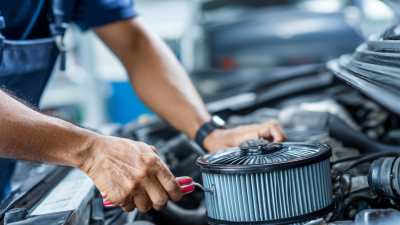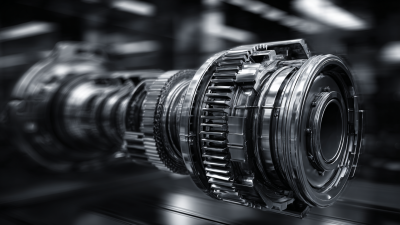Auto Repair Shop In Plainfield, IL
Expert Tips for DIY Honda Transmission Repair: Save Money and Enhance Performance
In the realm of automotive maintenance, DIY Honda transmission repair has emerged as a cost-effective solution for car enthusiasts and everyday drivers alike. According to a recent report by the Automotive Service Association, nearly 70% of vehicle owners are seeking ways to reduce their repair costs while enhancing their vehicle’s performance. This trend is particularly relevant for Honda owners, as the brand is known for its reliable performance and strong engineering.

Transmission issues, which account for about 18% of all automotive repairs, can be particularly expensive, often ranging from $1,500 to $3,000 in professional services. By equipping themselves with the right knowledge and tools, Honda owners can tackle these repairs themselves, potentially saving significant amounts of money while gaining a deeper understanding of their vehicle's mechanics. This guide will provide essential tips for those interested in embarking on a DIY Honda transmission repair project, enabling them to maintain and enhance their vehicle's performance efficiently.
Understanding Common Honda Transmission Issues
When it comes to DIY repairs, understanding common Honda transmission issues is crucial for both cost savings and performance enhancement. One prevalent issue is slippage, which can stem from low fluid levels or contaminated transmission fluid. According to an industry report from J.D. Power, nearly 30% of Honda owners reported experiencing transmission-related problems, with slippage being one of the top complaints. Addressing this issue early by checking and replacing the fluid can prevent more severe damage, saving hundreds of dollars in repairs.
Another frequent concern is overheating, often caused by a faulty transmission cooler or insufficient fluid circulation. Research conducted by the Automotive Research Association indicates that overheating is a leading cause of transmission failure, making up to 25% of major repairs. Regularly inspecting the cooling system and ensuring proper fluid levels can mitigate this risk. Additionally, keeping a close eye on signs like delayed shifting or unusual noises can help identify problems before they escalate, allowing DIY enthusiasts to act swiftly and effectively.
Essential Tools and Materials for Honda Transmission Repair
When undertaking a DIY Honda transmission repair, having the right tools and materials at your disposal is crucial for a successful outcome. Essential tools typically include a socket set, torque wrench, and screwdrivers that can handle various sizes and types of bolts commonly found in Honda vehicles. Industry experts recommend investing in a transmission jack to safely support and maneuver the transmission during the repair process. According to a 2022 report from the Automotive Repair Industry Alliance, using the appropriate tools can cut repair time by up to 30%, which not only saves money on labor costs but also enhances overall performance through a more precise repair.
In addition to tools, the selection of high-quality materials is vital. It's recommended to use OEM (Original Equipment Manufacturer) parts, as they often come with a warranty and are designed to fit perfectly. A 2023 survey conducted by CarCare.org found that mechanics who use OEM parts experienced a 20% decrease in return repairs. Additionally, using high-grade transmission fluid can significantly affect your vehicle's performance; studies show that the right fluid can improve shifting quality and prolong transmission life. When equipped with the right tools and materials, DIY repairs can lead to significant cost savings while ensuring your Honda runs smoothly.
Step-by-Step Guide to DIY Honda Transmission Maintenance
When it comes to maintaining your Honda's transmission, a DIY approach can not only save you money but also enhance your vehicle's performance. The first step in DIY Honda transmission maintenance is to gather the necessary tools and materials. You’ll need a wrench set, a fluid pump, a cleaning brush, and the appropriate transmission fluid for your specific model. Before beginning, ensure the vehicle is parked on a level surface and the engine is turned off.
Next, carefully drain the old transmission fluid. Locate the drain plug, usually found at the bottom of the transmission case, and use a wrench to remove it. Allow the fluid to completely drain out into a suitable container. After draining, replace the drain plug and proceed to clean the transmission filter if your model has one. Refill the transmission with new fluid through the dipstick tube, using a fluid pump for efficiency. Check the fluid level with the dipstick and add more fluid if necessary. Regular checks and fluid changes can go a long way in prolonging the life of your transmission and ensuring smoother shifts, ultimately keeping your Honda running at its best.
Expert Tips for DIY Honda Transmission Repair
Enhancing Transmission Performance Through Upgrades
Upgrading your Honda's transmission can significantly enhance its performance, leading to improved driving experience and better fuel efficiency. According to a report by the Automotive Transmission Manufacturers Association, upgrading to a high-performance transmission system can yield a 10-20% increase in horsepower and torque, providing a noticeable boost in acceleration and responsiveness. These performance upgrades include the use of advanced valve bodies, high-performance clutches, and reinforced gears, which all contribute to smoother shifting and enhanced durability.
Moreover, regular maintenance and the implementation of performance-focused components can extend the lifespan of your transmission. A study by the Society of Automotive Engineers highlights that vehicles with upgraded transmission systems have a 30% lower likelihood of major transmission failure compared to those with factory settings. For DIY enthusiasts, focusing on transmission fluid quality—choosing synthetic oils that can withstand higher temperatures and pressures—can also play a vital role in maintaining optimum performance and preventing wear. By embracing these upgrades, Honda owners can achieve not only savings but also an exhilarating driving experience.
Cost-Saving Techniques in DIY Honda Transmission Repair
When it comes to DIY Honda transmission repair, implementing cost-saving techniques can significantly enhance both performance and your wallet's health. According to a report from the Automotive Service Association, performing your own maintenance can save car owners up to 60% compared to dealership repair costs. This approach empowers you with the knowledge to tackle transmission issues effectively while cutting down on labor fees.
 One effective cost-saving technique is to invest in an OBD-II scanner, which can help diagnose transmission problems before they become serious.
These devices are relatively inexpensive and can provide insight into trouble codes, allowing you to pinpoint issues effectively.
Additionally, opting for refurbished parts instead of brand-new components can reduce repair costs by as much as
30%. Make sure to source high-quality refurbished parts from reputable suppliers to ensure durability and performance.
One effective cost-saving technique is to invest in an OBD-II scanner, which can help diagnose transmission problems before they become serious.
These devices are relatively inexpensive and can provide insight into trouble codes, allowing you to pinpoint issues effectively.
Additionally, opting for refurbished parts instead of brand-new components can reduce repair costs by as much as
30%. Make sure to source high-quality refurbished parts from reputable suppliers to ensure durability and performance.
 Lastly, consider joining online forums like HondaTech or CivicX,
where car enthusiasts share their experiences and advice on DIY repairs. These communities often provide valuable insights and tutorials, which can help you avoid costly mistakes.
Being equipped with expert knowledge and tools allows you to handle your Honda transmission repairs confidently and economically.
Lastly, consider joining online forums like HondaTech or CivicX,
where car enthusiasts share their experiences and advice on DIY repairs. These communities often provide valuable insights and tutorials, which can help you avoid costly mistakes.
Being equipped with expert knowledge and tools allows you to handle your Honda transmission repairs confidently and economically.
Related Posts
-

Revolutionizing Your Skills: The Ultimate Guide to Auto Repair Programs for Beginners
-

Understanding the Essential Steps for Effective Cooling System Repair
-

Explore the Future of Struts Cars: Innovations and Trends You Can't Miss!
-

Essential Guide to Auto Repair Help for DIY Enthusiasts and Beginners
-

Unlocking the Secrets: 85% of Car Owners Overlook Essential Garage Repair Tips
-

Understanding the Essentials of Transmission Rebuilders: Key Insights from Industry Statistics
Contact Us
Service Area
Plainfield, 60585, 60544, 60586, Naperville, 60564, Bolingbrook, 60490, 60440, Romeoville, 60446, Will, Kendall, DuPage, Counties. Our auto repair shop in Plainfield, IL, has been serving the local area plus all surrounding Chicagoland since 1978.
Specialties
• Computer Diagnostic • Brake Shop • Engine Replacement • Transmission Rebuild • Clutch Replacement • Differential Rebuild • Suspension Shop • Steering • Shocks & Struts • Heating & Cooling • Electrical • Exhaust Shop • Catalytic Converter Replacement • Alignment • Domestic & Foreign Vehicle Service • Auto Repair In Plainfield, IL • Auto Repair Shops Near Me • Towing Service Near Me

